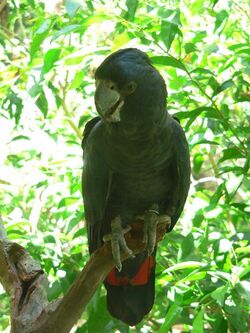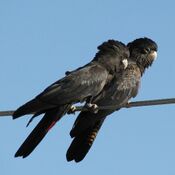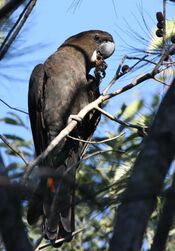Biology:Calyptorhynchus
| Calyptorhynchus | |
|---|---|

| |
| Calyptorhynchus banksii | |
| Scientific classification | |
| Domain: | Eukaryota |
| Kingdom: | Animalia |
| Phylum: | Chordata |
| Class: | Aves |
| Order: | Psittaciformes |
| Family: | Cacatuidae |
| Subfamily: | Calyptorhynchinae Bonaparte, 1853 |
| Genus: | Calyptorhynchus Desmarest, 1826 |
| Type species | |
| Psittacus banksii[1] Latham, 1790
| |
| Species | |
|
Two | |
Described by French naturalist Anselme Gaëtan Desmarest in 1826,[2] the genus Calyptorhynchus has two species of cockatoos. They are all mostly black in colour, and the taxa may be differentiated partly by size and partly by small areas of red, grey, and yellow plumage, especially in the tail feathers. Studies based on the mitochondrial DNA 12S gene fragment suggested that other sexually dichromatic species, the gang-gang cockatoo and the cockatiel may be the closest living relatives of Calyptorhynchus.[3] However, subsequent studies, including more genes confirm the morphological taxonomy with the gang-gang cockatoo most closely related to the galah, within the white cockatoo group, and with the cockatiel as a third distinct subfamily of cockatoos.[4]
| Subgenus | Image | Scientific name | Common name | Subspecies | Distribution |
|---|---|---|---|---|---|
| Calyptorhynchus - black-and-red cockatoos |  |
Calyptorhynchus banksii | Red-tailed black cockatoo |
|
Australia |
 |
Calyptorhynchus lathami | Glossy black cockatoo |
|
eastern Australia. |
The Yellow-tailed black cockatoo, Baudin's black cockatoo and Carnaby's black cockatoo were previously included in Calyptorhynchus as subgenus Zanda. However, based on genetic divergence Zanda was recognised as a genus and the three species transferred out of Calyptorhynchus.[5]
References
- ↑ "Psittacidae". The Trust for Avian Systematics. https://www.aviansystematics.org/4th-edition-checklist?viewfamilies=67.
- ↑ Desmarest, Anselme Gaëtan (1826). "Parrots" (in fr). Dictionnaire des Sciences Naturelles dans lequel on traite méthodiquement des différens êtres de la nature.... 39 (PEROQ–PHOQ). Strasbourg: F.G. Levrault. pp. 21, 117. OCLC 4345179.
- ↑ (Brown & Toft, 1999).
- ↑ White, Nicole E. (2011). "The evolutionary history of cockatoos (Aves: Psittaciformes: Cacatuidae)". Molecular Phylogenetics and Evolution 59 (3): 615–622. doi:10.1016/j.ympev.2011.03.011. PMID 21419232. http://researchrepository.murdoch.edu.au/id/eprint/4397/.
- ↑ Gill, F.; Donsker, D.; Rasmussen, P., eds. "Family Cacatuidae". International Ornithological Congress. https://www.worldbirdnames.org/Family/Cacatuidae.
Further reading
- Astuti, Dwi (2004?): A phylogeny of cockatoos (Aves: Psittaciformes) inferred from DNA sequences of the seventh intron of nuclear β-fibrinogen gene. Doctoral work, Graduate School of Environmental Earth Science, Hokkaido University, Japan. PDF fulltext
- Brown, D.M.; Toft, C.A. (1999). "Molecular systematics and biogeography of the cockatoos (Psittaciformes: Cacatuidae)". Auk 116 (1): 141–157. doi:10.2307/4089461.
- Higgins, P.J. (1999). Handbook of Australian, New Zealand and Antarctic Birds. Volume 4: Parrots to Dollarbird. Melbourne: Oxford University Press. ISBN 978-0-19-553071-1.
Wikidata ☰ Q834904 entry
 |

